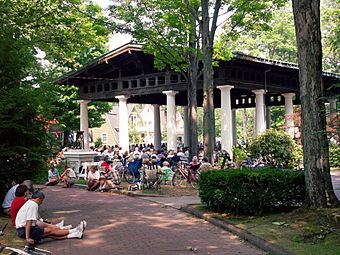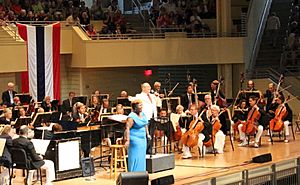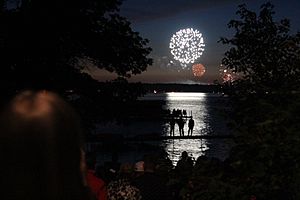Chautauqua Institution facts for kids
|
Chautauqua Institution Historic District
|
|

Hall of Philosophy
|
|
| Location | Chautauqua, NY |
|---|---|
| Nearest city | Jamestown |
| Area | 2,070 acres (8.4 km2) |
| Built | 1874 |
| Architect | John Vincent, Lewis Miller |
| Architectural style | Late Victorian and other late 19th and early 20th-century architectural styles. |
| NRHP reference No. | 73001168 |
Quick facts for kids Significant dates |
|
| Added to NRHP | June 19, 1973 |
| Designated NHLD | June 29, 1989 |
The Chautauqua Institution (say "shə-TAW-kwə") is a special place in Chautauqua, New York. It's a non-profit center for learning and a summer resort. It covers about 2,070 acres (8.4 km²) and is located in southwestern New York State.
The Institution started in 1874. It became the home and inspiration for the Chautauqua movement. This movement became very popular across the United States. The Chautauqua Institution Historic District is a National Historic Landmark. This means it's a very important historical place.
Contents
History of Chautauqua
Chautauqua was founded in 1874. Lewis Miller, an inventor, and John Heyl Vincent, a Methodist Bishop, started it. It began as a teaching camp for Sunday-school teachers. Teachers would arrive by steamboat on Chautauqua Lake. They would then study the Bible and learn about the geography of the Holy Land. They used a special area called Palestine Park for this.
The Institution has been open every summer since it started. It has grown a lot over the years. Now it offers many programs in arts, education, religion, and music. People can enjoy public events like concerts, theater, ballet, and art shows. There are also fun activities and special study programs. These programs help students who want to become professionals in arts.
The Institution's location on the west shore of Chautauqua Lake shaped its growth. It started with tents, then added cottages and hotels. Today, there are also condominiums.
In 1973, the National Park Service added the Institution to the National Register of Historic Places. Later, in 1989, it became a National Historic Landmark District. This area includes most of the Institution's property.
Programs and Activities
Every summer, for nine weeks, Chautauqua Institution offers many programs. These include fine arts, performances, lectures, and religious services. There are also many fun recreational activities. Nearly 100,000 visitors come to Chautauqua each year.
To enter the grounds, you need a "gate ticket." This ticket lets you use the library, beaches, and parks. It also lets you attend lectures and concerts. Some activities, like films, opera, theater, tennis, and golf, cost extra. You can rent cottages and rooms for your stay.
Weekly Programs

During the week, Chautauqua has a regular schedule. Mornings often start with religious services and a lecture. The lecture might be about social, political, or academic topics. In the afternoon, there's usually another talk on religion or politics. Evenings feature entertainment at the Amphitheater. This could be a concert by the Chautauqua Symphony Orchestra. It might also be a dance show or a performance by a guest artist.
Most weeks, you can see an opera and a play. These are performed by Chautauqua's own summer companies. Operas are sung in English at Norton Hall. This building has a cool art-deco style from the 1930s. There are also organ recitals, student performances, and special classes.
Many special courses are available in music, art, dance, and drama. The Chautauqua Schools of Music offers very competitive programs. They even have scholarships. Famous composer George Gershwin visited Chautauqua. He composed parts of his Concerto in F here.
Sundays at Chautauqua have worship services for different faiths. In the afternoon, there's an Amphitheater program. This might be a military band or a student dance show. On Sundays, entrance to the Institution grounds is free.

Special Events
One special event is "Old First Night." It happens on the first Tuesday of August. This event is like a "birthday party" for the Institution. It celebrates the opening of the first season in 1874. Many facilities host fundraisers on this night. These include a fun run, a lip-sync contest, and a bake sale. All money raised helps the Chautauqua Fund.
Another favorite event is the Fourth of July show. It features patriotic music at the Amphitheater. Afterward, you can watch fireworks over Chautauqua Lake. Sometimes there are barbecues at Bestor Plaza, the town square. Weekly sailboat races are also part of the fun.
Programs for Children
The Children's School started in 1921. It's a preschool for kids aged 3–5. It was one of the first programs of its kind. It offers social, recreational, and educational activities. These often include music, drama, art, and games.
The Chautauqua Boys and Girls Club is one of the oldest day camps in the U.S. It was founded in 1893. While parents enjoy other activities, kids meet by the lake. They play sports, do art, and enjoy games. Activities include volleyball, sailing, swimming, and pottery.
Buildings and Facilities
The Institution's grounds are between New York State Route 394 and Chautauqua Lake. They have public buildings, offices, a library, and a movie theater. There's also a bookstore, a hotel, and many private cottages for rent. About 400 people live here all year. But during summer, the population can reach 7,500 guests daily.
Chautauqua is mostly a walking community. Bikes and scooters are popular. Cars have a 12-mph speed limit when allowed on the grounds. Visitors usually park outside and then walk or bike in.
- The Amphitheater is a large performance space. The old 4,000-seat building was replaced in 2016-2017. The new 4,500-seat Amphitheater looks like the old one. It has modern features and is easier to access.
- The Athenaeum Hotel is the only hotel owned by the Institution. It has 156 rooms. It's said to be the largest wooden building in the eastern United States. It was built in 1881. It has a two-story porch and a central tower. While fewer hotels are on the grounds now, there are more condominiums.
- Palestine Park is a unique outdoor map. It's a scaled-down version of Palestine from the first century CE. It shows mountains, valleys, water, and cities in their correct places. Tours are offered to explain its history and religious meaning.
- The Elizabeth S. Lenna Hall is a large hall for music. It opened in 1993. It's used for rehearsals by the Chautauqua Symphony Orchestra. It's also a place for chamber music, voice, and piano recitals.
- The Lewis Miller Cottage was built in 1874. It was the home of Lewis Miller, who founded Chautauqua. It was named a National Historic Landmark in 1965.
The Chautauqua Prize
The Chautauqua Prize is an annual award for books. The Chautauqua Institution started it in 2012. The winner gets $7,500 and a one-week stay at Chautauqua. It honors a book of fiction or non-fiction that offers a great reading experience. It also celebrates the author's contribution to literature.
Chautauqua Declaration
The Chautauqua Declaration is an annual statement. It supports international efforts to bring human rights violators to justice. The first declaration happened in 2007. It included prosecutors from famous trials like the Nuremberg Trials. In 2017, the Tenth Chautauqua Declaration was made. Prosecutors from various international courts signed it.
The Chautauqua Movement
The Chautauqua movement spread across the United States. It followed the model of the Chautauqua Institution. It was very popular until World War II. By the 1920s, over 10,000 communities had Chautauqua events. More than 45 million people attended them.
The movement combined several ideas from the late 1800s:
- The Lyceum movement aimed to improve public education. It used lectures and entertainment for lifelong learning.
- Camp meetings and revivals were large outdoor gatherings.
- Sunday School provided religious education.
The ideas of the Chautauqua Institution spread through many independent Chautauqua groups. These traveling events included lectures, music, and religious studies. They also focused on current issues. Some independent Chautauquas still exist today.
The Chautauqua Literary and Scientific Circle (CLSC) started in 1878. It's one of America's oldest book clubs. It was founded to help people learn on their own. This was especially for those who couldn't go to college. Each year, six to nine books are added to the reading list. Authors often visit Chautauqua to talk about their books.
Famous Visitors
Many famous people have visited the Chautauqua Institution. These include politicians, celebrities, artists, musicians, and scientists.
Since 1874, four U.S. presidents have visited while in office. They were Ulysses S. Grant (1875), Theodore Roosevelt (1905), Franklin Delano Roosevelt (1936), and Bill Clinton (1996). In 1936, Franklin Delano Roosevelt gave his famous “I hate war” speech here. More than 12,000 people heard him speak. Future presidents Garfield (1880) and McKinley (1895) also visited.
Other notable figures include Booker T. Washington, Susan B. Anthony, and Amelia Earhart. Performers like John Philip Sousa, Duke Ellington, and Ella Fitzgerald have also been here. More recently, artists like Rhiannon Giddens and Toby Keith have performed.





